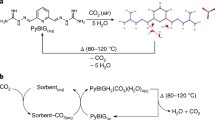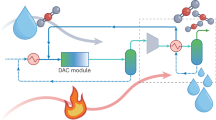Abstract
I conduct a system-level study of direct air capture of CO2 using techniques from thermal physics. This system relies on a combination of an efficient heat exchanger, radiative cooling, and refrigeration, all at industrial scale and operated in environments at low ambient temperatures. While technological developments will be required for such a system to operate efficiently, those developments rest on a long history of refrigeration expertise and technology, and they can be developed and tested at modest scale. I estimate that the energy required to remove CO2 via this approach is comparable to direct air capture by other techniques. The most challenging aspect of building a system that could remove 1 billion tonnes of CO2 from the atmosphere per year is the power demand of 112 to 420 GW during the wintertime operational period.


Similar content being viewed by others
Notes
en.wikipedia.org/wiki/Snag,_Yukon
calc.exergyllc.com
References
Agee EM, Orton A (2016) An initial laboratory prototype experiment for sequestration of atmospheric CO2. J App Meteor Climat. 55:1763–1770
Agee E, Orton A, Rogers J (2013) CO2 snow deposition in Antarctica to curtail anthropogenic global warming. J App Meteor & Climat 52:281–288
Archer D et al (2009) Atmospheric lifetime of fossil fuel carbon dioxide. Annu Rev Earth Planet Sci 37:117–134
Baxter, L, Baxter, A, & Burt, S (2009) Cryogenic CO2 capture as a cost-effective CO2 capture process. International Pittsburgh Coal Conference, Pittsburgh, PA. Available from: https://sesinnovation.com/news/documents/cccpittsburghcoalconference.pdf (Accessed 15/05/2017)
Bryson CE, Cazcarra V, Levenson LL (1974) Sublimation rates and vapor pressures of H2O, CO2, N2O, and Xe. J Chem Engin Data 19:107–110
Budzianowski, W M (2017) Assessment of thermodynamic efficiency of carbon dioxide separation in capture plants by using gas–liquid absorption. ed. W.M. Budzianowski, Energy efficient solvents for CO2 capture by gas–liquid absorption. pp. 13–26 (Springer International)
Chen Z, Zhu L, Raman A, Fan S (2016) Radiative cooling to deep sub-freezing temperatures through a 24-h day–night cycle. Nat Commun 7:13729
Clodic, D, & Younes, M (2002) A new method for CO2 capture: frosting CO2 at atmospheric pressure. Sixth International Conference on Greenhouse Gas Control Technologies, GHGT6, Kyoto, October 2002, pp.155–160
Collins, M et al. (2013) Climate change 2013: the physical science basis, (eds T F Stocker et al.) (Cambridge University Press, Cambridge)
Ehre D, Lavert E, Lahav M, Lubomirsky I (2010) Water freezes differently on positively and negatively charged surfaces of pyroelectric materials. Science 327:672–675
Framework Convention on Climate Change. (2016) Report of the Conference of the Parties on its twenty-first session, held in Paris from 30 November to 13 December 2015
Frieler K et al (2013) Limiting global warming to 2 °C is unlikely to save most coral reefs. Nature Clim. Change 3:165–170
Gattuso J-P et al (2015) Contrasting futures for ocean and society from different anthropogenic CO2 emissions scenarios. Science 349:aac4722
Hansen J et al (2008) Target atmospheric CO2: where should humanity aim? Open Atmos Sci J 2:217–231
Hugh N, Mathison M, Bowman A (2013) Modeling and testing of an R-23/R-134a mixed refrigerant system for low temperature refrigeration. A.S.H.R.A.E. Trans 119:1–8
IPCC climate change 2014: synthesis report (2014) (eds Pachauri, R K & Meyer, L A), (IPCC: Geneva, Switzerland)
Isaac M, van Vuuren DP (2009) Modeling global residential sector energy demand for heating and air conditioning in the context of climate change. Energy Policy 37:507–521
Joos F, Spahni R (2008) Rates of change in natural and anthropogenic radiative forcing over the past 20,000 years. Proc Natl Acad Sci U S A 105:1425–1430
Keith D, Ha-Duong M, Stolaroff J (2006) Climate strategy with CO2 capture from the air. Clim Chang 74:17–45
Keith, D W, Heidel, K, & Cherry, R (2009) Capturing CO2 from the atmosphere: rationale and process design considerations, in Launder, B and J M T Thompson, eds, Geo-engineering climate change: environmental necessity or Pandora’s box? pp 107–126 (Cambridge University Press)
Kelemen PB, Matter J (2008) In situ carbonation of peridotite for CO2 storage. Proc Natl Acad Sci U S A 105:17295–17300
Koplow, J P (2010) A fundamental new approach to air-cooled heat exchangers, Sandia Report, SAND2010–0258, pp 1–48 (Sandia National Laboratories: Albuquerque, NM)
Lackner KS et al (2012) The urgency of the development of CO2 capture from ambient air. Proc Natl Acad Sci U S A 109:13156–13162
Marty C et al (2003) Downward longwave irradiance uncertainty under arctic atmospheres: measurements and modeling. J Geophys Res 108(D12):4358
Matter JM, Kelemen PB (2009) Permanent storage of carbon dioxide in geological reservoirs by mineral carbonation. Nature Geo 2:837–841
Pandey R et al (2016) Ice-nucleating bacteria control the order and dynamics of interfacial water. Science Adv 2:e1501630
Parish TR, Bromwich DH (1987) The surface windfield over the Antarctic ice sheets. Nature 328:51–54
Petty GW (2008) A first course in atmospheric radiation, Second edn. Sundog Publishing, Madison, WI
Schleussner C-F et al (2016) Science and policy characteristics of the Paris agreement temperature goal. Nature Clim Change 6:827–835
Sipöcz N et al (2013) Low temperature CO2 capture for near-term applications. Energy Proc. 37:1228–1238
Song C, Kitamura Y, Jiang W (2013) Application of free piston Stirling cooler (SC) on CO2 capture process. Energy Proc 37:1239–1245
Stolaroff JK, Keith DW, Lowry GV (2008) Carbon dioxide capture from atmospheric air using sodium hydroxide spray. Environ Sci Technol 42:2728–2735
Strassmann KM, Plattner GK, Joos F (2009) CO2 and non-CO2 radiative forcings in climate projections for twenty-first century mitigation scenarios. Clim Dyn 33:737–749
Tuinier MJ, van Sint Annaland M, Kramer GJ, Kuipers JAM (2010) Cryogenic CO2 capture using dynamically operated packed beds. Chem Eng Sci 65:114–119
Walden VP, Warren SG, Murcray FJ (1998) Measurements of the downward longwave radiation spectrum over the Antarctic plateau and comparisons with a line-by-line radiative transfer model for clear skies. J Geophys Res 103:3825–3846
Acknowledgements
I thank Drs. M. Anthony Reynolds, Edwin J. Mierkiewicz, and Sandra Boetcher for helpful discussions and the reviewers for constructive criticisms that helped me improve and clarify this paper.
Author information
Authors and Affiliations
Corresponding author
Rights and permissions
About this article
Cite this article
von Hippel, T. Thermal removal of carbon dioxide from the atmosphere: energy requirements and scaling issues. Climatic Change 148, 491–501 (2018). https://doi.org/10.1007/s10584-018-2208-0
Received:
Accepted:
Published:
Issue Date:
DOI: https://doi.org/10.1007/s10584-018-2208-0




